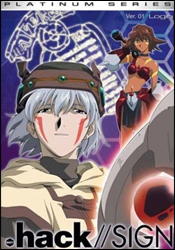 .hack//SIGN
.hack//SIGN
By Kellen Scrivens
10 October 2005 — The day was April 1st, 2005. The time was 9:30 pm. My level of anticipation was high. To try to get a little background on the series I read an issue of .hack//Legend of the Twilight Bracelet and loved it. So I was hoping that YTV putting .hack//SIGN on their programming schedule was not an April Fools joke. It wasn't.
It's now six months later and I have seen all 25 episodes. No matter what, I made sure I saw every single one. I cut out of party's early, I paid off friends in order to record the show while I was out of the country, I sacrificed just about every aspect of my social life in order to watch the show, and now, after all is said and done, all I can say is... April Fools! You really got me, boys. I actually thought I'd get a good anime.
.hack//SIGN is part of Bandai's incredibly large .hack franchise, which currently includes four PS2 titles, and several other TV shows and mangas. While .hack//SIGN is for the most part a standalone story, from time to time it does crossover into other aspects of the franchise — specifically the fourth game in the PS2 tetralogy, .hack//Quarantine. So unless you've played through the game, there are certain parts of .hack//SIGN that can become very confusing. Since I didn't play the game, I suffered from this — so take some aspects of my review with a grain of salt.
.hack//SIGN, just like everything else in the .hack universe takes place in The World, which is a Massively Multiplayer Online RPG much like Everquest and World of Warcraft, and that main story revolves around the wavemaster (a class in the game) Tsukasa. While he seems normal enough, Tsukasa does raise the ire of some. The Crimson Knights, a self-imposed group of police officers, chase after him because Tsukasa has been seen talking with an illegal (RE: hacked) player. Then there's the fact that his guardian is powerful enough to inflict pain on those in the real world, and that Tsukasa himself actually feels pain in the fictional World he inhabits. Oddest of all, Tsukasa cannot logout.
That — this inability to signoff — is the crux of the story. Along the way he encounters a number of people who wish to help him get home (RE: the real world), including Mimiru and Subaru — both females who are more than capable of wielding heavy blades and axes. Over the course of the series they are all fleshed out fairly well, however, the way it's done does not make for interesting television. For instance, an entire episode is dedicated to a character named BT who starts feeling bad because another person from The World refuses to meet her in real life. Yeah.
While the overall story itself may seem pretty damn straightforward, in reality it throws in a few too many unnecessary twists and turns (and I'm a guy that likes Survivor, for crying out loud); while Tsukasa's avatar in The World is male, he's actually a girl in the real world — but she vehemently denies it throughout the series. In fact, near the end of the run, Tsukasa and Subaru begin to fall in love.
Another black mark against the series is the massive number of characters. As I said before, the writers did an okay job building a few, but the rest are just sort of there. So you wind up not caring for a good number of them.
And frankly, most of the episodes are average at best. Yeah, they weren't incredibly bad (I did make it a point to continue watching it, after all), but they weren't incredibly good either. However, the one thing .hack//SIGN does have going for it is the last three episodes. They are stellar examples of good anime. That said, the last few minutes of the final episode are... well, headache indusingly bad.
As for the voice acting, the only bright spot was the net-psychopath Sora (David Wittenberg). Beyond that is a mess of mediocrity.
Despite all this, I remained an eternal optimist. But even my sanguinity won't allow me to score this as anything better than average. In fact, I can't even go that high.
Grade: 2 out of 5

